
CashOnHand - Transportation - Brandon - Spanish
- Subject:
- Business and Communication
- Education
- Finance
- Special Education
- Material Type:
- Lesson
- Date Added:
- 07/19/2021

CashOnHand - Transportation - Brandon - Spanish
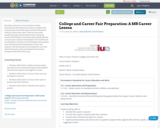
Secondary educators across Lebanon County, Pennsylvania developed lesson plans to integrate the Pennsylvania Career Education and Work Standards with the content they teach. This work was made possible through a partnership between the South Central PA Workforce Investment Board (SCPa Works) and Lancaster-Lebanon Intermediate Unit 13 (IU13) and was funded by a Teacher in the Workplace Grant Award from the Pennsylvania Department of Labor and Industry. This lesson plan was developed by one of the talented educators who participated in this project during the 2018-2019 school year.

Middle and High School educators from across Lebanon County, Pennsylvania developed lesson plans to integrate the Pennsylvania Career Education and Work Standards with the content they teach. This work was made possible through a partnership between the South Central PA Workforce Investment Board (SCPa Works) and Lancaster-Lebanon Intermediate Unit 13 (IU13) and was funded by a Teacher in the Workplace Grant Award from the Pennsylvania Department of Labor and Industry. This lesson plan was developed by one of the talented educators who participated in this project during the 2019-2020 school year.

This is a project based course designed to help middle school students explore career options using the Nebraska Career Education Model and understand the Nebraska Career Readiness Standards. The course is organized by three themes – Making it My Choice, A World of Options and Charting a Direction – with culminating individual and group projects. Students will define career clusters and pathways, describe examples of career readiness, utilize self-assessments to better understand interests, establish a career portfolio and create a personal learning plan to provide direction to high school and post-high school activities. This course is aligned to American School Counselor Association Standards for Students and integrates EducationQuest tools and resources for middle school students.
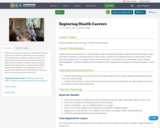
Students will use assessments on the Nebraska Career Connections website to determine career interests, values, and career confidence. Then they reflect on their results. Students are divided into teams of two based on their interests and given time to research health career information as outlined in the HOSA Health Career Display event guidelines. Students complete the HOSA Health Career Display board and give a formal presentation to their class.

Students use research and observation data (field trip) to objectively rank potential career opportunities to help guide their individual career choice and pathway. Learning goals/objectives: After completing this unit, students should be able to utilize an objective method for evaluating potential careers. Students will determine what career types and opportunities are best suited to themselves personally and defend their choices.

There are hundreds of different jobs in medicine. This activity is designed to introduce you to different healthcare professions and some of the websites where you can find more information about health-related occupations.By the end of this lesson, you will:Learn how to navigate and extract health careers information from websitesBecome familiar with various healthcare professions

Students learn how to use Google Slides to make a simple presentation about a career they have researched on www.mynextmove.org.
Lesson designed for use in a one-room schoolhouse ABE/GED program, where volunteer tutors and instructors work with students one-to-one.
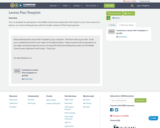
This is a template for participants in the Middle School Career Exploration Pilot Project to use in the construct of lessons, or to share existing lessons, with the broader network of Pilot Project partners.

Over the course of this five lesson unit, students will explore how their preferences, interests, needs, and strengths (PINS) connect to a future career. Lessons can be taught as stand alone or as a comprehensive unit.

My Next Move is an interactive tool for job seekers and students to learn more about their career options. My Next Move has tasks, skills, salary information, and more for over 900 different careers. Users can find careers through keyword search; by browsing industries that employ different types of workers; or through the O*NET Interest Profiler, a tool that offers personalized career suggestions based on a person's interests and level of work experience.

The Oregon Career Connected Learning Framework graphic provides a visual representation of Oregon's definition of CCL and potential activities that learners can participate in during their career education and development. Under the umbrella of Career Connected Learning, there are 4 domains: Awareness, Exploration, Preparation and Training. Within the 2 domains of Preparation and Training, lies the opportunity for Work-based learning.Users may incorporate this graphic into their work when communicating and providing professional development with regards to the CCL Framework and its four domains.

Construction & Architecture
Do you want to design, build, and maintain structures where people live, work, and play? This industry includes careers in designing, planning, managing, building, and maintaining the built environment. Careers in the architecture and construction industry involve designing and building homes, roads, and other structures. More than half of the occupations in this industry typically require a high school diploma or equivalent. However, specific designations range from less than a high school diploma and short-term on-the-job training for carpet installers to a bachelor’s degree and an internship for occupations such as architects.
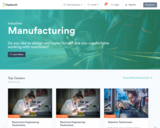
Manufacturing
Do you like to design and make things? Are you comfortable working with machines? This industry includes careers in planning, managing, and performing the processing of materials into intermediator final products and related professional and technical support activities, such as production planning and control, maintenance, and manufacturing/process engineering. Careers in the manufacturing industry involve making products, such as food, cars, and household goods. Most occupations in this industry typically require a high school diploma or equivalent, although specific designations range from less than a high school diploma and short-term on-the-job training for occupations such as production worker helpers to an associate’s degree and long-term on-the-job training for camera and photographic equipment repairers.

I can identify post secondary options of entering the workforce, completing an adult apprenticeship, military service, technical college, four year college public, four year college private. (review from 7th grade-discovering pathways)
I can explore district pathway maps.
I can explore careers of interest that require a high school diploma, technical college certificate, degree, and/or 4 year college
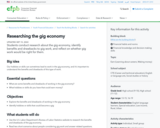
Students conduct research about the gig economy, identify benefits and drawbacks to gig work, and reflect on whether gig work would be right for them.

This learning tool will guide students through the process of understanding real-world applications of drug delivery and how drug delivery is applied to treating infectious diseases. Students using this module should find success in self-directed learning, though they may use additional resources in the community, the guidance of teachers, the advice of scientists or biomedical professionals at DDF, or the knowledge presented in scientific literature to help them achieve their goal; though this module should provide most of the tools they will need for guidance.

This unit plan is designed to spark students’ interest in critical thinking and scientific discovery. This unit is based on the book, “Survival of the Sickest: A medical maverick discovers why we need disease” by Jonathan Prince and Sharon Moalem. The book explores the evolution of different diseases throughout its eight chapters. The lesson plan is designed to take about 21 days (50-minute class periods). For this book, the class reads the Prologue together. Then, groups of students are assigned a chapter that they will teach to the class. Their teaching will include a presentation, activity, and facilitated discussion. (The unit plan helps the students learn how to do each of these tasks.) A final project is included at the end of the unit - a book review of the entire book. The summative grade for this unit is multi-part - the teaching assignment and the book review. Three quizzes are included, which would also be small summative grades. The notes packets and teaching planning sheets are all formative grades. A team member peer review is another part of the project.

These Hands Video - Afa: Auto Mechanic

These Hands - Ariele - Director at HSDC